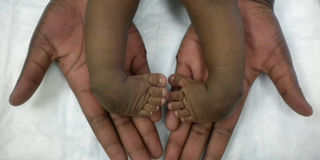Clubfoot deformity can be corrected

It is important for a pregnant woman to go for antenatal care so that treatment is offered as soon as possible. NET PHOTO
What you need to know:
- Cost. Lillian Nakisozi, an orthopedic officer at Kayunga General Hospital, says at government health facilities, clubfoot treatment is free. However, private clinics charge between Shs500,000 and Shs3m, depending on the health facility one goes to and the intensity of the deformity.
Last year, Harriet Nakiwala, 31, a resident of Nakaliro Village in Kayunga District gave birth to a bouncing baby girl at Kayunga Hospital. Although both Nakiwala and her husband were happy to have a baby girl, this happiness was short-lived after noticing that their baby’s feet were twisted inwards at the ankle. They were told that this kind of deformity is referred to as clubfoot.
Lillian Nakisozi, an orthopedic officer at Kayunga General Hospital, says clubfoot is a congenital deformity of the foot usually marked by a curled shape or twisted position of the ankle and heel and toes.
According to mayoclinic.org, in clubfoot is a fairly common birth defect and is usually an isolated problem for an otherwise healthy newborn. “Clubfoot can be mild or severe. About half of children with clubfoot have it in both feet. If your child has clubfoot, it will make it harder to walk normally, so doctors generally recommend treating it soon after birth,” site states.
“Clubfoot deformity can be corrected if is treated early. However, a number of parents believe it is witchcraft and never seek treatment,” Nakisozi says adding that clubfoot occurrences in the country stand at two children per every 1,000.
Causes
Swaibu Mukwaya, a physiotherapist, says the exact cause of clubfoot is still unknown although he notes that one of the likely causes could be the way the baby is positioned in the womb.
He also notes failure by pregnant mothers to go for ante-natal care where medical workers would be in position to detect and correct the abnormal position of the baby.
Another cause could be associated with domestic violence where a pregnant mother is battered leading to deformity of bones of the unborn baby.
Malnutrition could also be another cause. “In rural areas, where there is poor nutrition, clubfoot incidence is higher than in urban areas,” Mukwaya says citing a rural district such as Pallisa, where malnutrition levels are high, and one out of every 10 babies have clubfoot.
Treatment
Nakisozi says surgery can be carried out to correct the deformity. This, she says, would involve serial casting or what is known as the ponseti method. This involves a minor operation to correct the feet and later, the child is required to temporarily wear a small clubfoot shoe to position the limbs.
“It would also involve stretching and moving the child’s foot into a position. Then, a plaster cast is put to hold the foot in one position for a period of six weeks or more,” she says.
Physiotherapy can also be considered. “With physiotherapy, the child’s foot is gradually stretched to achieve the right position and later held in one place,” Mukwaya says.
Complications
According to medicalnewstoday, if left untreated, complications can occur.
There will usually be no pain or discomfort until the child comes to stand and walk. It will be hard to walk on the soles of the feet.
Instead, the child will have to use the balls of the feet, the outside of the feet, and in very severe cases the top of the feet. There is a long-term risk of eventually developing arthritis.
The inability to walk properly can make it difficult for a person with clubfoot to participate fully in some activities. The unusual appearance of the foot may also cause self-image problems.
Even with treatment, the foot will be between one and one-and-a-half times smaller than the other foot, and slightly less mobile. The calf of the leg will also be smaller.




